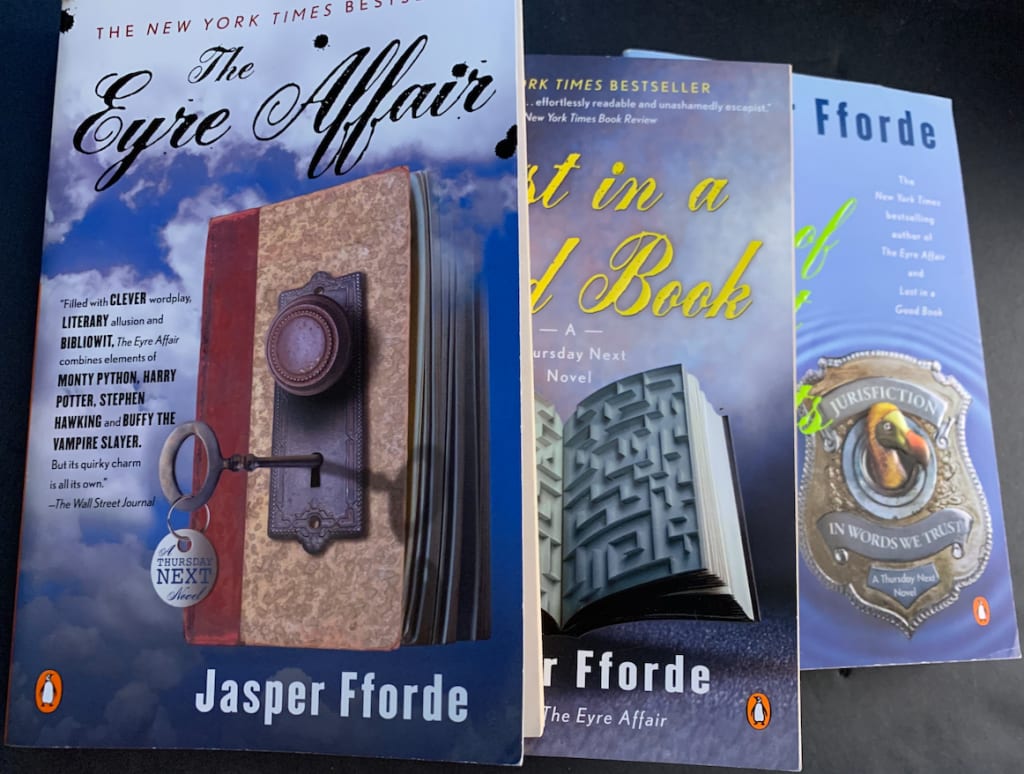The Nextian Universe of Jasper Fforde
Let's go bookjumping!

If you could chat with any character you’ve ever read about, who would it be? Would you be having tea with Hermione to discuss which spell she finds the most difficult? Would you take a leisurely stroll with Samwise Gamgee and have him show you the highlights of Hobiton? Might the possibility of having an audience with Gandalf, Merlin, and Dumbledore together at the same time be of interest to you? How about hanging out with Luke Skywalker and finding out he’s always had a crush on Marianne Dashwood? This is the setting of Jasper Fforde’s series beginning with The Eyre Affair.
In this world, characters and settings are not entirely fictional; there are two distinct worlds. You (the reader) and I (the writer of this piece) are in the RealWorld, aka the Outland (London, in this case). The words that create worlds and capture fiction and non-fiction are part of the BookWorld. These two worlds are connected, according to Fforde’s vision, and events that occur in one world can affect the other. For this storyline, you must engage in a great amount of suspension of disbelief. It also helps if you’re a prolific reader and believe time travel is possible. This storyline arc has elements of fantasy, literature, history, the craft of writing, science fiction, murder mystery, the allure of book collecting among other descriptions. I would be hard pressed to categorize these books as there’s no clear-cut genre that this series would fall under.
The heroine of the story is Thursday Next, a LiteraTec, and she’s a member of a crime fighting group Special Operations (SpecOp) 27, a law enforcement detail that deals with theft of books, fraud, copyright infringements, etc. In the first book, we learn that Thursday’s father is part of the ChronoGuard which controls how time is unraveled, stopped, crossed, and dispensed. At one point Thursday rescues her husband (from one of the various timelines) who’s stuck in “The Raven.” Thursday takes care of her pet dodo from a DIY cloning kit, thanks to time manipulation. It impacts history so the RealWorld becomes distorted. That allows many of the actions in the entire storyline to pop back and forth; rarely does anyone stay dead in the seven-book series. Thursday becomes part of the detective department within the books called the Jurisfiction where she can go into books and work with the Chronoguard to solve crimes.
Thursday is initially taught how to use a Prose Portal to go INTO books. She later learns an easier method called bookjumping that allows her to go sideways into the book plot. Once in a book or poem, she sees things as if she’s in a literary diorama; characters are in action when the book is being read, much like the movies Groundhog Day or Free Guy where the characters must recreate a basic plot the same way each time. When a book is static (unread), characters intermingle with others, visiting other books, having affairs, and carrying on mischief that keeps Thursday busy. Plots must stay the same; any changes in a plot in the BookWorld result in changes in books in the RealWorld. Antagonists abound; some want to kidnap characters, some want weaponry from the RealWorld used in the BookWorld because history is being rewritten, memories can be stolen, plots can be reversed.
This series setting is different from any other books that I’ve read. What made me laugh the most takes place in an AA-type meeting called Rage Counseling. It’s run by Ms. Havisham, and it revolves around why everyone hates Heathcliff. Of course, when it gets to Catherine, she becomes maudlin and insists she loves Heathcliff; the group starts arguing and descends into chaos. This reminded me a scene from Wreck-it Ralph where all the villains of various video games gather to have meetings called Bad-Anon where they discuss what it feels like to be the villain in their games. The mish mash of characters and bending of genres is different from any other book I’ve read.
I should add that the names of some of the characters amuse me as well: Thursday Next (her children Wednesday and Friday), Braxton Hicks, Jack Schitt, Jack Spratt, Oswald Mandias, and Millon de Floss. Minor characters can live in other books as long as they remain out of sight. Characters you wouldn’t put together in your mind abound in the BookWorld; Rochester and Thursday knew each other from an incident in Thursday’s childhood where she accidentally bookjumped. The absurd twists and turns in the series kept me waiting for the next book to come out. So many possibilities existed when these two worlds are interconnected.
In the BookWorld, there is a Great Library where all books ever written are kept. The Cheshire Cat is the caretaker there. There are basements and subbasements to house all languages across the age of the written word. Ms. Havisham becomes Thursday’s mentor and explains the concept of the Well of Lost Plots located within the Great Library; these are where unfinished and unpublished texts are kept. In the Well there are generic two-dimensional characters (figurative and literal) that disappear when they turn sideways. Sentences, words, phrases: all of these are in the Well.
I think of this as I write. Where do I pull ideas from? How do I know what I’m going to write next? Why did I use certain words or create characters the way I did? How should I phrase this thought? All these decisions are explained by existence of the Well of Lost Plots. Authors constantly draw from it and toss things back that are unwanted or unused. Unpublished manuscripts are in there. Sometimes books become unwritten, a dangerous crime committed as words from published books are pulled back into the Well from the Great Library, causing chaos in books in the RealWorld that use the same plots.
One crime Thursday works to resolve is prevention the publication of UltraWord that would make it impossible for people in the RealWorld to read a book more than three times, rendering libraries and re-sale stores obsolete. She also runs into curtailing grammasites, bugs that infect and erase writing. There are stolen punctuation marks that need to be located, missing chapters that need to be returned, and other literary issues like kidnappings, murders, and blackmail among characters. This explains the defective mechanics in e e cummings’ poetry, the unusually long sentences in Faulkner’s novels, and the missing punctuation in Joyce. Literary characters go on strike, refuse to return, and cause mayhem in the literary world when the books aren’t being read.
The possibilities of what could happen in this series is mind-boggling. In one chapter, Hamlet wants to come out into the RealWorld. He also wants to change the play he’s in to add the Merry Wives of Windsor and give his tragic play a happier ending. A Charles Dickens book is stolen and held for ransom; Shakespeare’s authorship question pops up causing the characters more pain and suffering. Genres of writing become fluid as characters float between books. This is why, Fforde implies, we sometimes feel déjà vu when reading a book – we’ve seen a character or setting just like it somewhere else.
The writers’ craft is broken down into its constituent parts. The processes that writers go through to write a book or story are exposed and treated as separate entities, not a combined unified effort to “write a book.” Plot devices can be traded and sold in back allies, mechanics are available in shops for sale, and languages are intentionally mistranslated. Words are commodities.
I turn around and look at my own library. As I’m sitting here writing, and the books behind me are not being read. Does Stephanie Plum (Evanovich) sneak over and have a glass of wine with Thursday Next (Fforde), talking about detective work? Is Chaz Perrone (Hiassen) chilling with Serge Storms (Dorsey)? Are Augustan Burroughs and Ellen DeGeneres discussing the difficulties that LGBTQ+ are facing today? Are Charlie (Keyes, Flowers for Algernon) and Alex (Burgess, Clockwork Orange) arguing over who has the worse life with all that experimentation? It’s much like Toy Story and Night at the Museum but with mix-and-match literary characters and time travel; quiet time is when they come to life.
This series, as fun as it is, requires dedication. Timelines are intercrossed; mammoths and other creatures are resurrected, technology has improved or disappeared, references to detective work are a mainstay, and a good literary classic background is highly encouraged. According to Goodreads, references to 124 other books and poems are sprinkled throughout the series. This may seem an atypical fantasy world, but it’s fun reading, full of inside humor, and just a wonderfully insane imaginative escape. I’m looking forward to more of this series coming out.
About the Creator
Barb Dukeman
After 32 years of teaching high school English, I've started writing again and loving every minute of it. I enjoy bringing ideas to life and the concept of leaving behind a legacy.






Comments
There are no comments for this story
Be the first to respond and start the conversation.